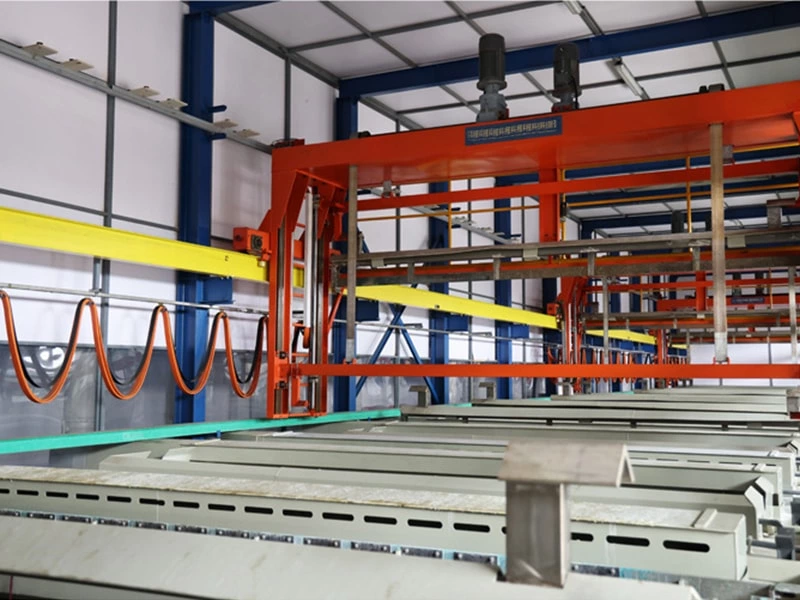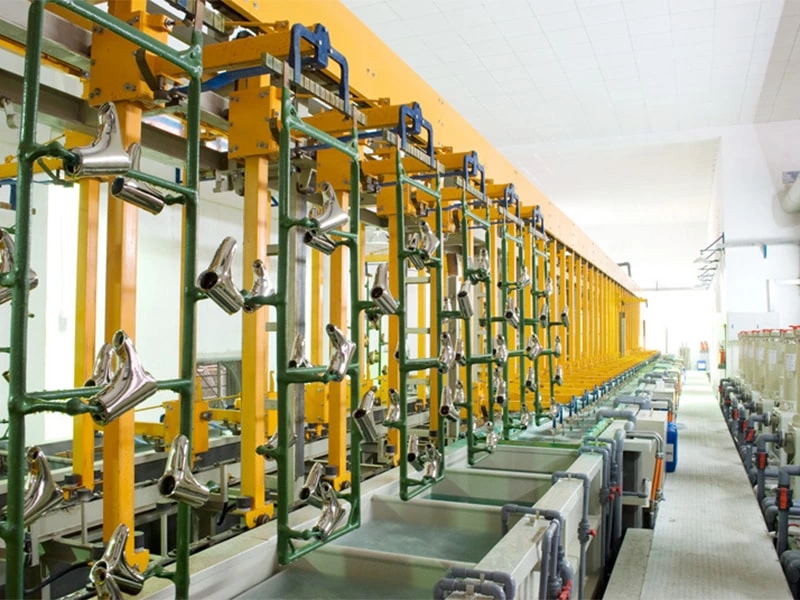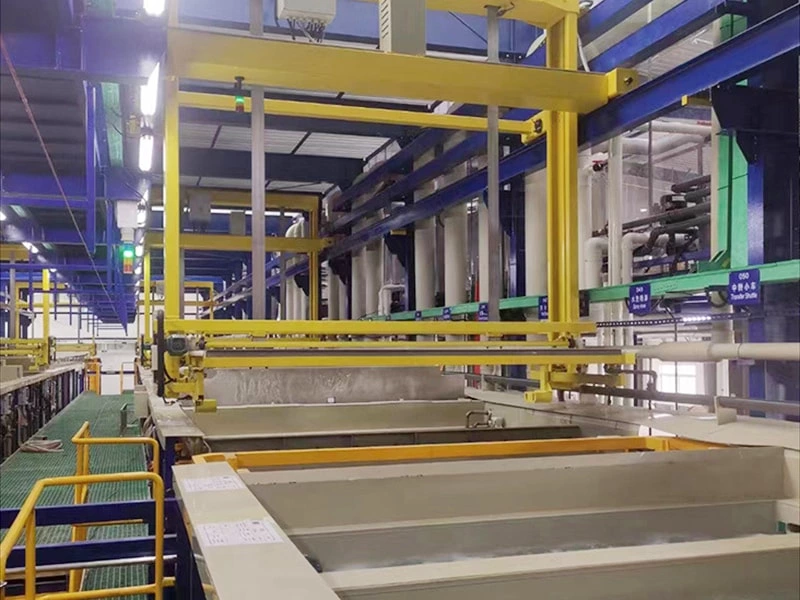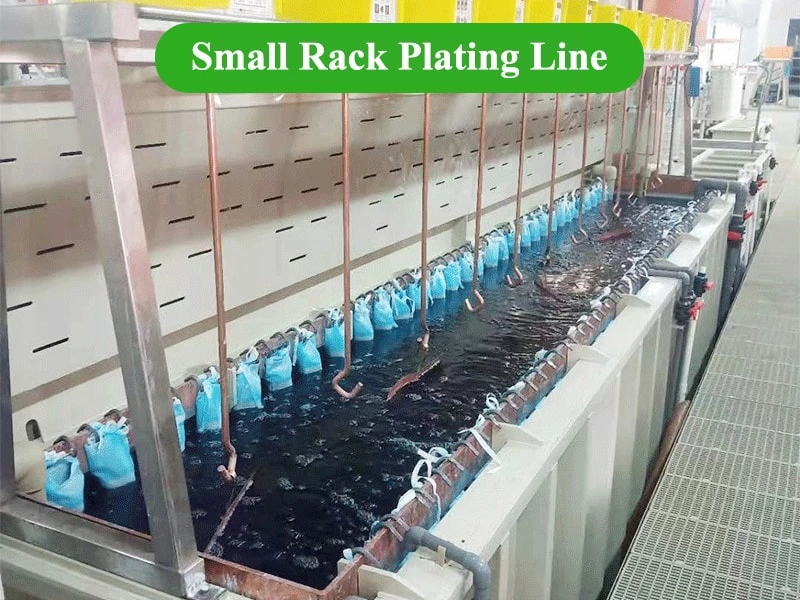Introduction To Linear Electroplating Automatic Production Line
First, Electroplating Automatic Production Line Preface
The electroplating automatic production line is a modern equipment that works continuously in strict accordance with pre-established working procedures, process flow and plating time requirements.
It not only has fast and stable operation, high output, stable quality, and saves a lot of manpower, but also is widely recommended by national environmental protection departments because of its full utilization of energy and less pollution.

There are two main types of automatic production lines for rack plating or barrel plating:
Straight linear and circular lines.
It's suitable for various plating types and surface treatment processes such as cleaning, blackening, electrophoresis, phosphating, and aluminum anodizing.
The linear automatic production line takes out the plated workpieces in the plating tank and then puts the unplated workpieces in order to meet the plating time requirements. It is characterized by simple machinery and complex electrical control, so the quality of electrical components is particularly critical.
The circular electroplating automatic production line advances the plated parts gradually or at a constant speed in the plating tank to meet the plating time requirements. It is characterized by slightly complex machinery and relatively simple electrical controls, so the quality of mechanical components is particularly critical.
Since the circular electroplating automatic production line cannot run in reverse, it is difficult to change the process. It is only suitable for occasions where the process is very mature. In addition, the cost is high. Therefore, linear automatic production lines that can freely reciprocate often become the preferred type for initial investment companies and are widely used.
Here we focus on the composition, performance and characteristics of the linear electroplating automatic production line, so that users and craftsmen can make targeted choices and utilize them to maximize benefits with the most economical investment.
In short, the automatic electroplating production line is not as random as the manual electroplating line, and changes are more troublesome. Therefore, it is particularly critical to develop a reasonable process flow.
Due to the high investment in electroplating production lines, decisions must be made thoughtfully, maturely, and long-term. The selection should be comprehensively considered from several aspects such as its own strength, output size, variety range, quality requirements, management level, degree of automation, and development goals.
Second, Output Of Linear Automatic Production Line
1. Takt time / T
The takt time is the time it takes for the electroplating worker to move up and down the next hanger (or bucket) of workpieces. The shorter the cycle time, the more hangers (or barrels) produced per unit time.
The cycle time of the linear electroplating automatic production line is generally 5 to 6 minutes, that is, 12-10 hanging (or barrel) plated parts can be produced per hour, and the shortest time can be 2.5 minutes, which can be adjusted according to actual needs.
Although the shorter the cycle time and the higher the output, the plating tank may require more stations, the entire line will be longer, and the required electroplating power supply, conductive copper bars, heating energy, etc. will also be larger. Costs will increase accordingly. In addition, the number of vehicles required will also increase.
Since each electroplating crane needs to be raised, lowered, forward or backward one step at a time, the cycle time is too short, and the control range of each crane becomes narrower, leaving little room for operation.
Therefore, the cycle time should be properly determined according to actual needs, and shorter is not always better.
2. Quantity of plated parts per hanger (or per barrel) / G
For rack-plated parts, the amount of each rack-plated part is related to the width and height of the tank. The wider the width, the more hanging fixtures can be placed, and the deeper the height, the longer the hanging fixtures can be placed.
The discharge range of parts should consider the placement of the pipeline and the movement direction of the cathode: the horizontal direction should be 200~300mm shorter than the tank width, and the height should be 350~400mm shorter than the tank body.
Although the wider and deeper the plating tank (the maximum width can be more than 7 meters) and the higher the output, the required materials, electroplating power supply, conductive copper bars, heating energy, etc. will also increase significantly.
If the plating tank is too high, the pressure of the liquid will increase. Not only the tank wall must be strengthened, but also it will take up the cycle time of the driving operation (the plated parts will be discharged first, and the plated parts will be discharged first, which is also detrimental to the quality of the coating), so it is not You don’t have to do this as a last resort.
The width of the plating tank of the linear rack plating automatic production line is generally between 1600mm and 3000mm. The height is generally between 1100 and 1600mm.
For barrel plated parts, the amount of plated parts per barrel is related to the size of the drum and is generally measured by weight. The discharge of parts generally does not exceed one-third of the total capacity of the drum (except for cleaning and phosphating).
The width of the barrel plating tank needs to match the size of the drum.
When the drum length is 750mm, the groove width is generally 1100mm (load-bearing capacity is generally ≤60kg); when the drum length is 900mm, the groove width is generally 1300mm (special drum load-bearing capacity can reach 120kg). The depth of the plating tank has nothing to do with the output, but the plating tank The large tank volume can maintain the stability of the tank liquid for a long time.
In addition to the large investment for the first time, it does not increase consumption, and it can also accommodate accumulated impurities for a longer period of time.
3. Calculation of output
The output and cycle time of the linear electroplating automatic production line T (minutes) and the number of pieces per hanger N (the number of hangers per hanger multiplied by the number of parts on each hanger) or the amount of plated parts per barrel G (kg or pieces) related.
The output per hour (60 minutes) is: N×(60/T) or G×(60/T)
Note: This is the output during normal operation, excluding the time required to load the first batch of parts when restarting and the last batch before shutdown (this time is related to the length of the process flow).
Based on the daily working shifts (hours) and the number of working days per year, the daily output and annual output can be calculated.
Some linear electroplating automatic production lines use double hanging cranes per station, and their output can be doubled.
However, since the distance between the two hangers in the plating tank cannot be too small, this forces the washing and other auxiliary tanks of the entire electroplating line to be widened (if variable spacing lifting is used, the driving structure will be very complicated), so the entire line will be very long.
Therefore, this method can only be properly considered when there are many plating tanks and few auxiliary tanks.





